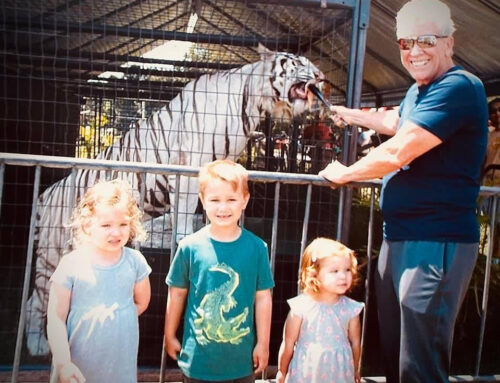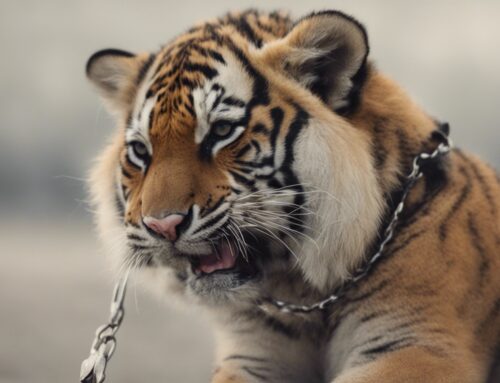Central Florida Animal Rescue CFAR
|
|||
| Customer No: | 6987 | ||
| Certificate No: | 58-C-0615 | ||
| Certificate Status: | ACTIVE | ||
| Status Date: | Jan 15, 1998 |
|
As of Oct 2015 there were still 36 big cats on the property.
| 2 | LEOPARD | WILD/EXOTIC FELINES |
| 2 | LION | WILD/EXOTIC FELINES |
| 4 | PUMA | WILD/EXOTIC FELINES |
| 30 | TIGER | WILD/EXOTIC FELINES |
As of June 2011 there were 49 big cats still on the property and a deadline of 2011 to move them out of the neighborhood.
| 3 | LEOPARD | WILD/EXOTIC FELINES |
| 6 | LION | WILD/EXOTIC FELINES |
| 4 | PUMA | WILD/EXOTIC FELINES |
| 36 | TIGER | WILD/EXOTIC FELINES |
As of Sept. 9, 2011 the Central Florida Animal Rescue website still condones the breeding of captive tigers. When the board of the Central Florida Animal Rescue took over from Ray Thunderhawk, Big Cat Rescue offered to step in and neuter all of the male tigers to stop the breeding but CFAR refused. By 2009 they reportedly had 75 tigers living in overcrowded cages on 2 acres of land in a residential neighborhood.
2011 CFAR Not Showing Good Faith to End Their Breeding
From Big Cat Rescue: We have toured their board before and I had extensive email correspondence with Effie Blue about neutering their cats to stop the breeding. They had 75 cats on less than 2 acres in a woman’s back yard. The cats were tearing through the chain link and killing each
other. We offered to pay our vet to come neuter the males, but they insisted the only way they would do it would be if we paid their vet 500. Per cat to do one at a time in his clinic. We could have had Dr Wynn do ten times that many in one visit for the same cost and felt they were whacking us around as they wee still, at that time a year or so ago, taking cubs to the sanford flea market.
2010 Central Florida Animal Rescue Says They are Moving
VIERA — Zapped by zoning requirements, Central Florida Animal Reserve officials plan to perform more legal research on their proposed exotic-cat compound near Scottsmoor.The big-cat rescue group must move from its Canaveral Groves home to a properly zoned site. So CFAR wants to build a larger home for its 51 lions, tigers, cougars and leopards on 17 rural acres off U.S. 1, near the Volusia County border.
But because limited public tours would eventually occur, county code classifies this proposed complex as a zoological park, Assistant County Attorney Christine Lepore told the Brevard County CommissionThursday.
According to a 1979 zoning ordinance, Brevard zoological parks — including “serpentariums, aviaries and large public aquariums” –cannot construct cages within 300 feet of a residential property line.
Cage locations depicted in the CFAR site plan fail to meet this requirement, Commissioner Chuck Nelson said.
“What you’re setting yourself up for is failure,” Nelson said.
For the third time since February, commissioners decided to table a decision on a captive-wildlife permit for the Scottsmoor site. This time, debate resumes in September.
CFAR President Thomas Blue remarked he was surprised by the zoological-park classification, as did Commissioner Andy Anderson.
About 10 residents in the vicinity of the target site lobbied for commissioners to reject the proposal. Eloise Shamblin, who lives next door, believes it is merely a matter of time before a deadly cat escapes.
“Of course, their security will be ‘fail safe.’ We all have seen examples of fail safe security in the Gulf of Mexico,” Shamblin quipped, referring to the BP oil spill.
Harold Birkhead, another potential neighbor, said he does not want to patrol his property with a shotgun while his grandchildren play in the yard.
“Tigers jump 20 feet. (CFAR’s) really good-natured, these people — they’re going to put an 8-foot fence up. Hell, I could pole vault over an 8-foot fence and I’m 76 years old,” Birkhead said.
Conversely, Candy Bradshaw lives next door to CFAR’s current Canaveral Groves caged compound. She said she was apprehensive when she moved in a little more than a year ago, but she now loves the furry carnivores.
“I don’t have a problem with the noise. I don’t have a problem with the odor. I have my nieces, great-nieces, great-nephews all out in the yard,” Bradshaw said. “My mom lives there with me. She loves to hear them.”
Commissioner Trudie Infantini asked if the county could lease CFAR a site on Environmentally Endangered Lands property. Lepore said that land use is likely incompatible, but county staffers can research the idea.
Contact Neale at 242-3638 or rneale@floridatoday.com.
Ray Thunderhawk FKA Ray Grennell
On March 24, 2009 Brevard County Commission told the Central Florida Animal Rescue CFAR (formerly Thunderhawk’s) they will have to move from their current location. The ruling states the sanctuary must move to agriculturally zoned property within two years. The property they occupy now is zoned general use and is in a residential neighborhood on 2 acres.
The claws come out in tiger custody fight
BY JOHN A. TORRES
FLORIDA TODAY
Tigers taken. Ray Thunderhawk and his fiancee, Brenda Williams, look into a cage that once housed baby tigers. Amanda Stratford, FLORIDA TODAY
What’s next
The parties will meet in court at 8:30 a.m. Feb. 12 before Judge George Turner at the Viera courthouse.
Ray Thunderhawk spends most of his time in the company of danger.
Years ago, he lost two fingers to an alligator he was working with at a theme park. Then, he decided to dedicate his life to tigers and other big cats.
Now he is in what he calls the scariest situation of his life.
Late last year, Thunderhawk was banned from seeing the tigers, lions and cougars he raised and cared for. In turn, he is suing his ex-girlfriend and others in a custody case unlike most that have come before Judge George Turner.
At issue are 15 adult tigers and several cubs with an estimated value of about $200,000 — a figure Thunderhawk said he only begrudgingly calculated — and the leadership of the animal welfare group he helped found more than a decade ago.
“This may rub people the wrong way, but I lost a son years ago, and this is just as devastating,” he said. “I have been forced to put a monetary value on the cats. How do you put a figure on your kids?”
Neither Sharon Farrar, Thuderhawk’s former girlfriend, nor any other member of the new board of directors at Central Florida Animal Reserve would elaborate on why Thunderhawk was voted off the board.
“Mr. Thunderhawk has chosen to discuss the lawsuit he filed against the corporation and board, and some of its associated topics, in various public forums instead of limiting it to court,” Farrar wrote in an e-mail. “The board will not do so.”
Removed from board
Central Florida Animal Reserve, known until recently as Thunderhawk Enterprises, cares for rescued cats and aims to keep them from being exploited or from inappropriate living conditions.
The trouble, Thunderhawk said, started 18 months ago when his seven-year romantic relationship with Farrar ended. Thunderhawk Enterprises had moved to Farrar’s property in west Cocoa several years earlier and Thunderhawk lived on the compound. After the breakup, he was asked to leave the premises and was allowed back only on a limited basis to care for the animals.
Then, according to his attorney, John Boelke, the nonprofit company and the cats were “stolen” from Thunderhawk when the board, acting without his knowledge, removed his name as the registered agent.
“If you make changes and you don’t have authority, then it’s a violation of Florida statute, and it’s a felony. It’s fraud,” Boelke said. “That’s one of the things in our complaint. They have removed him from the board without authority.”
At an emergency hearing in Turner’s court on Dec. 6, Animal Reserve board member Julia Kunigan said she had no way of reaching Thunderhawk to inform him of the change made in April, when he was still president and chairman of the board.
“A few months later, we found an address,” she said as she testified about why she put her name down as registered agent. “At that time, I talked to the other board members, and they said go ahead and put my name down.”
Boelke said Kunigan’s testimony is preposterous since Thunderhawk was on the property regularly and Farrar knew his cell phone number and where he was living.
Turner did not grant a temporary injunction for Thunderhawk.
As the head of the operation, Thunderhawk was mainly a showman, Boelke said, working to raise money through fundraisers and shows. His downfall, Boelke said, was being computer illiterate.
“It’s a sad situation,” he said. “He relied on his girlfriend to maintain things.”
Farrar did not wish to be interviewed for this story. Instead, she provided a prepared statement from the Animal Reserve and then a revision. Both were sent via e-mail.
The statement said everything was done legally and that the decision to remove Thunderhawk was not an easy one.
“The change in management was a very hard decision, but was necessary for the long-term survival of the organization and thus all our cats, which belong to the organization and are supported solely by the organization through its charitable activities,” the statement read.
It went on to say Thunderhawk, though removed from limited administrative duties, would still be able to care for the animals.
“The board’s intention was not to remove him from participating with the company and the cats,” the statement continued. “His threat to sue and ultimately his choice to litigate instead of cooperate with the decisions of the appointed Board of Directors resulted in him no longer being allowed on private property.”
Turner did order Farrar and her staff to report to Boelke or Thunderhawk any “instances of terminal illness, impending sale or any severe injury or disposition of any animal.”
Since that hearing, a tiger chewed his way out of his enclosure and into another tiger’s, then killed that tiger. No one called Boelke or Thunderhawk to report this, Boelke said.
Officer Mike King of the Florida Fish and Wildlife Commission confirmed the incident did occur.
Farrar did not address questions about the incident in her
e-mails to FLORIDA TODAY.
‘I want my cats’
Thunderhawk predicted additional dangerous incidents at the compound as the cats vie for his position.
“I was the alpha tiger, and the alpha tiger is gone now,” he said.
Thunderhawk says he owned several cats before the corporation was formed and he is entitled to them and their offspring. That some of the cats were allowed to breed was a contentious point between Thunderhawk and Farrar.
He acknowledged that selective breeding — among the pure bloodlines — was sometimes done to help with fundraising by taking the cubs to shows. Other births, however, were accidental, as the tigers were part of a contraceptive study.
Boelke said the breeding was so limited that only six or seven cubs were born during the past five years.
The next court date is Feb. 12, where Turner will rule on the new board’s request to dismiss the suit.
“They stole my corporation and took my cats,” Thunderhawk said. “I want my cats back.”
Please contact Torres at 242-3649 or jtorres@floridatoday.comThis e-mail address is being protected from spambots. You need JavaScript enabled to view it and let him know that big cats do not belong in backyards, basements, garages and certainly not in the hands of people like Ray Thunderhawk.
The following was posted on Florida Today and you can also add your comments there.
http://www.floridatoday.com/apps/pbcs.dll/article?AID=/20080202/NEWS01/802020326
Dear John Torres,
It is well known to everyone in the animal protection community that Ray Thunderhawk purposely inbred white tigers to produce babies that he would then drag out to flea markets for attention and ill gotten gain. There is absolutely NO reason for anyone to breed white tigers and you can learn more about that at Big Cat Rescue‘s web page called White Tigers.
In USDA reports from 2004 Thunderhawk listed 14 big cats and by 2007 had more than 70. He did not rescue cats, but rather bred them and has close ties to other low life back yard breeders. He relied on the ignorance of the public about how white tigers are produced and their lack of accessibility to see how he was caging the animals. 75 big cats crowded into the muddy backyard of a residential home in Cocoa that sits on less than 2 acres, is not what anyone would consider humane or ethical.
Big Cat Rescue has offered to help spay and neuter the cats so that Ray’s “accidental” births (which were never part of any contraception program as he claimed) but required that Ray surrender possession to his board as his actions prove that he does not have the well being of the cats in mind. It was a tough decision for his board to take over the facility, but they are remarkable people and they know that the only way to end the abuse is to stop the breeding. We will help them in any way we can and hope that the public will do so as well.
This is a very sad situation and the good people on the board of CFAR are to be applauded for stepping up and taking action to protect the cats from the likes of Ray Thunderhawk.
Posted by: Carole Baskin, Founder of Big Cat Rescue on Sun Feb 03, 2008 5:40 pm





Leave A Comment
You must be logged in to post a comment.